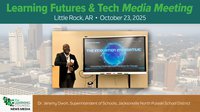More than a decade after their first appearance in classrooms, it’s clear that interactive whiteboards (IWBs) and panels can engage students. But there are also barriers that prevent schools and teachers from even getting started with these potentially effective instructional technologies: cost, the need for training, and the limits on concurrent use by many students, to name a few.
To address these issues, schools and districts have moved to the cloud—the next evolution of collaborative canvases for K-12 teachers and students is “whiteboarding without walls.” What exactly does that mean? A solution for next-generation whiteboarding and 21st-century collaboration is called Ormiboard.
This tool transforms any device into an interactive whiteboard, breaking down barriers and fostering collaboration among teachers and students. Any smartphone, tablet, computer, or existing IWB or panel can become a whiteboard that goes beyond just being “interactive” and becomes a giant collaborative canvas in the cloud that connects classrooms, homes, and everywhere in between.
When we unleash the power of existing computers, 1:1 programs, and BYOD devices to allow whiteboarding anytime and anywhere, every student in the class benefits and teachers achieve a new level of interactivity. Whiteboarding in the cloud provides a hassle-free and seamless canvas for collaboration where students and teachers can create and actively participate in assignments together as part of a given lesson.
With a device- and OS-agnostic system connecting every device in (or out of) the classroom, working together becomes simple: If you can connect to the internet, you can connect with your classmates and your teachers to collaborate. This is an improvement on many IWBs that only allow a few students (at most) to come up to the board and take an active part in the lesson. With cloud-based whiteboarding, every student can participate on their own device at their own pace. Couple that with the ability to instantly share one or more student displays to front-of-class displays, and teachers are several steps closer to whole-class participation where every student is engaged in working with peers, rather than isolated in front of their own device.
Whether teachers have an IWB display on the wall or not, any classroom can harness the power of whiteboarding in the cloud after about a minute of set-up time. Extending the whiteboarding experience to 1:1 or BYOD devices enables teachers to track student performance and progress individually or in groups. Teachers can record responses and track student performance in an integrated manner, then customize content and offer individualized support during and after activities.
Today’s students live on their mobile devices, so it just makes sense for educators to meet them where they are and help them use their phones not just to play Pokemon Go, but to learn about art, math, English, geography, science, and music.
But’s that’s just the beginning of what true collaboration can empower students to learn. For example, districts across the country are encouraging students to learn HTML coding. Cloud-based whiteboarding is an efficient way to have students work on this vital STEM skill on their own devices and then be able to share their work to with peers and teachers to get real-time feedback. With a whiteboard in the palm of their hands 24 hours a day, they are able to see the fruits of their labors where they want, when they want. and across the curriculum.
By supporting communication, collaboration, creativity, productivity, and technology literacy, cloud-based whiteboarding truly brings K-12 classrooms into the 21st century.











